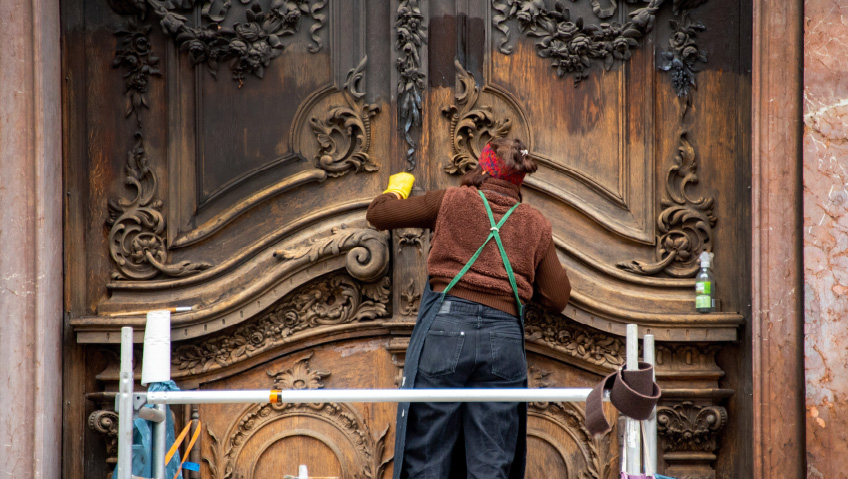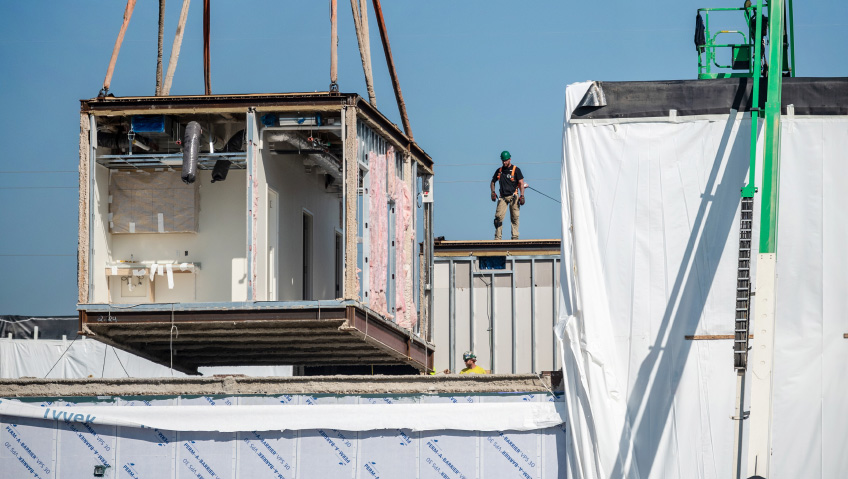For first-time homeowners, buying an old house often comes with wide-eyed intrigue. Centuries-old leaded glass windows, carved wooden doors, ornate scrollwork and gingerbread trim, porcelain or glass doorknobs, and even well-worn staircases all hold a certain charm, even mystery. Who lived in the house? Could there be treasures hidden behind the walls?
Like an archeologist excavating a dig site, renovating an old house or other building often comes with discoveries—some good, others disappointing. Renovations follow trends, and it isn’t unusual to tear up a once-fashionable pink or forest green wall-to-wall carpet from the 1970s and discover layers of linoleum or gorgeous old hardwood beneath.
Sometimes, renovations can turn yesterday’s trash into treasure, with new owners finding long-sealed safes or decades-old bottles of alcohol. While renovating an old home in British Columbia in 2020, workers discovered dozens of original movie posters in remarkable condition behind walls and beneath floorboards. Originally used as insulation, once-worthless posters from the 1930s advertising movies like The Petrified Forest and The Bride of Frankenstein have since sold for $50,000 or more each.
Not every old property undergoing renovation contains valuables, and sometimes trash is just, well, trash. Every contractor has stories of finding old cigarette packs, used coffee cups, broken beer bottles, and food wrappers in air vents and behind walls, usually left by workers from years past. Movies like 1986’s The Money Pit, featuring a young Tom Hanks, and its predecessor, 1948’s Mr. Blandings Builds His Dream House, with Cary Grant, reveal the perils of buying a fixer-upper, from unanticipated costs to fix weak foundations to re-routing underground streams to replacing support beams.
Although Hollywood likes to exaggerate the pitfalls of old homes, the reality is, many historic properties still contain knob and tube wiring, lead paint, fragile clay pipes, asbestos, mold, Polychlorinated Biphenyls (PCBs), aluminum wiring, termite damage, and even radioactive materials in soil. These hazards, and others, often require specialists trained in removing dangerous old insulation, wiring, and plumbing.
Then there is the issue of heritage properties. Depending on where the property is located, different rules apply, as many cities, states, and provinces have by-laws protecting historic homes. In Toronto, for example, these by-laws fall under the Ontario Heritage Act. Created to help preserve the province’s heritage, homeowners and contractors alike need to be aware of the dos and don’ts before doing any upgrades, repairs, or renovations.
Reasons for historic preservation vary. Often, it is to ensure future economic growth and development, conserve “important places for the benefit and enjoyment of present and future generations,” according to the Act, and attract tourist dollars. Historic homes, schools, churches, and banks are sometimes transformed into restaurants, stores, libraries, and coffee shops on the inside, but exterior elements typically need to be preserved to maintain their vintage charm.
While many construction companies perform additions and renovation work, performing work on centuries-old structures requires specialized experience and knowledge of by-laws, architecture, and more. To maintain authenticity and preserve a building’s character, renovators must have an in-depth understanding of modern and period construction methods and materials. The old and the new must be carefully balanced. Depending on the scope of the project, this may include bringing experts on board including historians and researchers, engineers, and architects familiar with period buildings.
From restoring old homes up to the recently completed, five-year-long resurrection of Paris’s Notre-Dame Cathedral—which sustained significant fire damage in 2019—historic renovation requires advance planning. In the case of Notre-Dame, which dates back to the Middle Ages, modern technology including robots, drones, and thermal imaging were used to assess damage, while augmented reality (AR), 3D mapping, and laser scanning were used to create a “digital blueprint” of the complex structure, writes Frank Kalman for Built – The Bluebeam Blog. The work was no small challenge for the renovation team, who worked tirelessly on the beloved cathedral, which has sections dating back to 1163. To safeguard workers, some 460 tons of lead—which melted in the fire—were removed.
For months, all eyes were on the UNESCO World Heritage site, with many questioning if the team could make the building whole again. Where possible, damaged limestone was replaced with similar stone from quarries used in the original construction. Instead of re-using old wood, fire-resistant materials and reinforced metal were strategically concealed beneath, to safeguard against potential fires. And to ensure all enjoy the cathedral for years to come, a new sound system, energy-efficient lighting, and ramps were installed. Centuries of dirt were scrubbed from the limestone exterior, and Notre-Dame’s legendary spire was rebuilt to look exactly as it did before the inferno.
Not every historic renovation is as dramatic and costly as that of Notre-Dame, although more contractors are using some of the same state-of-the-art technology in their own projects. Another consideration is environmental: once-trusted materials, such as lead paint and asbestos—widely used in insulation, vinyl floor tiles, adhesives, and popcorn ceilings until the 1980s—are now known to be toxic to humans and the environment. These products and others must be tested and safely removed.
Depending on the scope of the work, getting approvals to renovate heritage buildings can take years. Some structures, such as churches, often require objects such as hand-carved pews, carvings, sculptures, paintings, stained glass windows, copper roofs, and more to be painstakingly removed, evaluated, repaired if necessary, stored, and put back in place. Sourcing vintage materials like old stone can be a challenge, as can finding qualified people to perform the work.
In the United States, there are different departments regulating the renovation of old buildings. The U.S. General Services Administration (GSA), an independent federal agency, has in-depth information on Historic Preservation Policy, Tools, and Resources, such as federal legislation protecting and preserving historic building and sites and details on the National Historic Preservation Act (NHPA), which became law in 1966.
The Secretary of the Interior’s Standards for the Treatment of Historic Properties “provide guidance to historic building owners and building managers, preservation consultants, architects, contractors, and project reviewers prior to beginning work.” And others, like the National Institute of Building Services, have plenty of information on Historic Preservation. Through the Whole Building Design Guide (WBDG), the Institute states: “Preserving historic buildings is vital to understanding our nation’s heritage. In addition, it is an environmentally responsible practice… This not only makes good economic sense, but preserves our legacy and is an inherently sustainable practice and an intrinsic component of whole building design.”
Restoring heritage properties is certainly not for the faint of heart, but when done well, it can be greatly worthwhile. Whether it’s uncovering a long-forgotten relic behind a wall or breathing new life into a historic landmark, renovating older properties is a delicate blend of discovery, craftsmanship, and respect for the past. While challenges abound, and the work is best left to the experts, the reward lies in seeing history restored, not erased.






